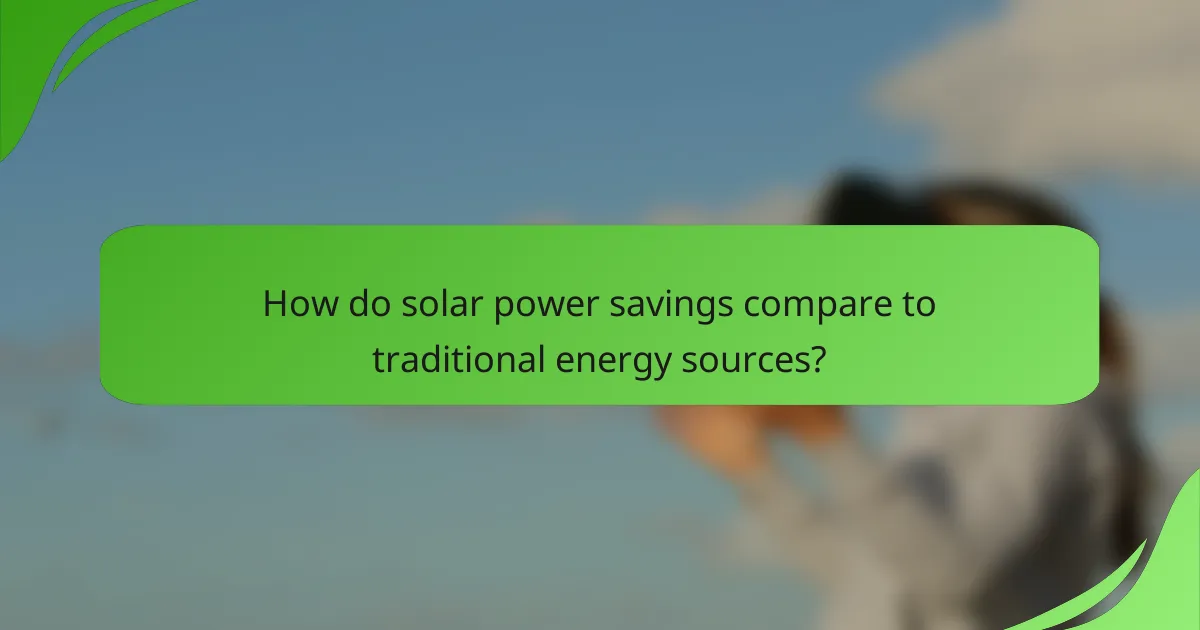Installing solar power systems offers homeowners substantial long-term cost savings by reducing electricity bills and providing tax incentives. By leveraging the abundant sunlight, residents not only enjoy financial benefits but also contribute to a sustainable energy future. Understanding the factors that influence these savings can help maximize the return on investment for both homeowners and businesses.

How can solar power installation save costs in California?
Solar power installation can significantly reduce long-term costs for homeowners in California by lowering electricity bills, providing tax incentives, and stabilizing energy prices. By harnessing the abundant sunlight, residents can enjoy financial benefits while contributing to a more sustainable energy future.
Reduced electricity bills
One of the primary ways solar power installation saves costs is through reduced electricity bills. By generating your own electricity, you can decrease your reliance on the grid, leading to monthly savings that can range from hundreds to thousands of dollars over time.
In California, where electricity rates are among the highest in the nation, these savings can be particularly impactful. Homeowners can expect to see a significant reduction in their utility bills, especially during peak usage times when rates are elevated.
Tax incentives and rebates
California offers various tax incentives and rebates that can help offset the initial costs of solar power installation. The federal solar investment tax credit (ITC) allows homeowners to deduct a percentage of the installation costs from their federal taxes, providing substantial savings.
Additionally, California’s state programs, such as the California Solar Initiative, offer rebates that can further reduce upfront costs. These incentives can make solar power more financially accessible, encouraging more homeowners to invest in renewable energy.
Net metering benefits
Net metering allows solar power users to sell excess electricity back to the grid, providing additional savings. When your solar system generates more energy than you consume, the surplus is credited to your utility account, effectively lowering your future bills.
In California, net metering policies ensure that homeowners receive fair compensation for their contributions to the grid, making solar power not only a cost-saving measure but also a way to support the local energy infrastructure.
Long-term energy price stability
Investing in solar power can provide long-term energy price stability, shielding homeowners from fluctuating electricity rates. Once installed, solar systems generate free energy, allowing homeowners to avoid rising utility costs associated with traditional energy sources.
In California, where energy prices can vary significantly due to market conditions, solar power offers a predictable and stable energy cost, making it a smart financial decision for the future.

What are the long-term financial benefits of solar power?
The long-term financial benefits of solar power include significant savings on energy bills, increased property value, and lower maintenance costs. Over time, these advantages can lead to a substantial return on investment, making solar power a financially sound choice for homeowners.
Increased home value
Installing solar panels can enhance your home’s market value. Studies suggest that homes with solar energy systems sell for more than those without, often adding thousands of dollars to the property price. This increase can be particularly beneficial in regions with high electricity costs.
Potential buyers are often attracted to homes with solar installations due to the promise of lower utility bills. This demand can make your property more competitive in the real estate market.
Lower maintenance costs
Solar power systems typically require minimal maintenance, which translates to lower ongoing costs for homeowners. Most solar panels come with warranties that last 20-25 years, ensuring long-term reliability without frequent repairs.
Regular cleaning and occasional inspections are usually sufficient to keep the system functioning efficiently. This low maintenance requirement helps homeowners save money over the lifespan of the solar installation.
Return on investment over time
The return on investment (ROI) for solar power can be substantial over time. Homeowners can expect to recoup their initial installation costs through energy savings, often within a decade. After this period, the energy produced is essentially free, leading to significant savings.
Factors affecting ROI include local electricity rates, available incentives, and the initial cost of installation. In many cases, federal and state incentives can further enhance the financial benefits, making solar power an increasingly attractive investment.

What factors influence the cost savings of solar power?
The cost savings from solar power installations are influenced by several key factors, including system size, local energy rates, and installation costs. Understanding these elements can help homeowners and businesses maximize their financial benefits over time.
System size and capacity
The size and capacity of a solar power system directly affect its energy output and, consequently, the cost savings it generates. Larger systems typically produce more electricity, which can lead to greater savings on energy bills. However, the initial investment is also higher, so it’s essential to balance size with budget and energy needs.
When considering system size, evaluate your average energy consumption and available roof space. A common approach is to aim for a system that covers around 70-100% of your energy needs, depending on your financial goals and local incentives.
Local energy rates
Local energy rates play a crucial role in determining the financial benefits of solar power. Higher electricity prices mean greater savings when you generate your own power. For instance, if your local utility charges around 0.15-0.25 USD per kilowatt-hour, the savings from solar can be substantial over the system’s lifespan.
Additionally, some regions offer net metering, allowing you to sell excess energy back to the grid at retail rates. This can further enhance your savings, making it vital to research your local energy policies and rates before installation.
Installation costs
Installation costs can vary significantly based on location, system complexity, and labor rates. On average, residential solar installations in the U.S. can range from 15,000 to 30,000 USD before incentives. It’s essential to obtain multiple quotes from reputable installers to ensure competitive pricing.
Consider available incentives, such as federal tax credits or state rebates, which can substantially lower upfront costs. Researching local programs can help you maximize your savings and make solar power more affordable.

How do solar power savings compare to traditional energy sources?
Solar power savings can significantly exceed those from traditional energy sources over time due to lower operational costs and incentives. By harnessing sunlight, homeowners and businesses can reduce their reliance on fossil fuels, leading to substantial long-term financial and environmental benefits.
Cost per kilowatt-hour analysis
The cost per kilowatt-hour (kWh) for solar energy typically ranges from low to mid single digits in USD, depending on location and installation specifics. In contrast, traditional energy sources like coal or natural gas may cost higher, often fluctuating based on market conditions and regulatory changes.
When evaluating solar installations, consider the initial investment, available tax credits, and local utility rates. For example, in many regions, solar panel installations can lead to savings of 50% or more on monthly energy bills compared to conventional sources.
Environmental impact considerations
Solar power offers a cleaner alternative to traditional energy sources, significantly reducing greenhouse gas emissions. By switching to solar, households can contribute to a decrease in air pollution and reliance on finite resources, promoting a more sustainable energy future.
Additionally, many governments incentivize solar adoption through rebates and tax credits, further enhancing its appeal. However, it is essential to consider the environmental impact of manufacturing solar panels and their end-of-life disposal, ensuring a holistic approach to sustainability.

What are the prerequisites for solar power installation?
Before installing solar power systems, homeowners must assess roof suitability and understand local regulations. These prerequisites ensure that the installation is efficient, compliant, and maximizes energy savings.
Roof suitability assessment
Evaluating roof suitability involves checking the structure’s orientation, angle, and material. Ideally, roofs should face south or southwest and have a pitch between 15-40 degrees for optimal sunlight exposure.
Additionally, the roof should be in good condition, as solar panels typically last 25 years or more. If repairs are needed, it’s advisable to address these before installation to avoid additional costs later.
Local regulations and permits
Local regulations can vary significantly, so it’s essential to research zoning laws and building codes in your area. Many municipalities require permits before installation, which can involve submitting plans and undergoing inspections.
Homeowners should also check for any incentives or rebates available for solar installation, as these can help offset costs. Consulting with local solar installers can provide insights into specific requirements and streamline the permitting process.
